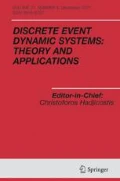Abstract
This paper considers the problems of fault diagnosis and supervisory control in discrete event systems through the context of a new observation paradigm. For events that are considered observable, a cost is incurred each time a sensor is activated in an attempt to make an event observation. In such a situation the best strategy is to perform an “active acquisition” of information, i.e. to choose which sensors need to be activated based on the information state generated from the previous readings of the system. Depending on the sample path executed by the system, different sensors may be turned on or off at different stages of the process. We consider the active acquisition of information problem for both logical and stochastic discrete event systems. We consider three classes of increasing complexity: firstly, for acyclic systems where events are synchronized to clock ticks; secondly, for acyclic untimed systems; and lastly, for general cyclic automata. For each of these cases we define a notion of information state for the problem, determine conditions for the existence of an optimal policy, and construct a dynamic program to find an optimal policy where one exists. For large systems, a limited lookahead algorithm for computational savings is proposed.
Similar content being viewed by others
References
Andersland MS, Teneketzis D (1992) Information structures, causality, and non-sequential stochastic control, I: design-independent properties. SIAM J Contr Optim 30(6):1447–1475
Andersland MS, Teneketzis D (1994) Information structures, causality, and non-sequential stochastic control, II: design-dependent properties. SIAM J Contr Optim 32(6):1726–1751
Andersland MS, Teneketzis D (1996) Measurement scheduling for recursive team estimation. J Optim Theory Appl 89(3):615–636
Appadwedula S, Veeravalli VV, Jones DL (2002) Robust and locally-optimum decentralized detection with censoring sensors. In: Proceedings of the 5th international conference on information fusion. Annapolis, MD, USA
Athans M (1972) On the determination of optimal costly measurement strategies for linear stochastic systems. Automatica 8:397–412
Cassandras CG, Lafortune S (1999) Introduction to discrete event systems. Kluwer Academic Publishers, Boston, MA
Debouk R, Lafortune S, Teneketzis D (2002) On an optimization problem in sensor selection. J Discret Event Dyn Syst: Theory and Appl 12:417–445
Ding X, Puterman ML, Bisi A (2002) The censored newsvendor and the optimal acquisition of information. Oper Res 50:517–527
Holloway L, Chand S (1994) Time templates for discrete event fault monitoring in manufacturing systems. In: Proceedings of the 1994 American control conference, pp 701–706
Jiang S, Kumar R, Garcia HE (2003) Optimal sensor selection for discrete-event systems with partial observation. IEEE Trans Syst Man Cybern Part B 30(5):653–660
Jiang S, Huang Z, Chandra V, Kumar R (2001) A polynomial algorithm for testing diagnosability of discrete-event systems. IEEE Trans Automat Contr 46(8):1318–1320
Khanna M (1973) Sampling and transmission policies for controlled Markov processes with costly communication. Ph.D. thesis, Department of Electrical Engineering, University of Toronto
Kumar PR, Varaiya P (1986) Stochastic systems: estimation, identification, and adaptive control. Prentice Hall, Englewood Cliffs, NJ
Kushner HJ (1964) On the optimum timing of observations for linear control systems with unknown initial state. IEEE Trans Automat Contr 9(2):144–150
Kushner HJ (1971) Introduction to stochastic control. Holt, Rinehart, Winston
Lafortune S, Teneketzis D, Sampath M, Sengupta R, Sinnamohideen K (2001) Failure diagnosis of dynamic systems: an approach based on discrete event systems. In: Proceedings of the 2001 American control conference, pp 2058–2071
Lunze J, Schröder J (2001) State observation and diagnosis of discrete-event systems described by stochastic automata. Discret Event Dyn Syst: Theory Appl 11(4):319–369
Meier III L, Peschon J, Dressler RM (1967) Optimal control of measurement subsystems. IEEE Trans Automat Contr 12(5):528–536
Pencolé Y (2000) Decentralized diagnoser approach: application to telecommunication networks. In: Proceedings of the 11th international workshop on principles of diagnosis (DX’00), pp 185–192
Pollard D (2002) A user’s guide to measure theoretic probability. Cambridge Univ. Press
Rago C, Willett P, Bar-Shalom Y (1996) Censoring sensors: a low-communication-rate scheme for distributed detection. IEEE Trans Aerosp Electron Sys 32(2):554–568
Rozé L, Cordier M-O (1998) Diagnosing discrete-event systems: an experiment in telecommunication networks. In: Proceedings of the 1998 international workshop on discrete event systems (WODES ’98). Published by IEE, London, England. pp 130–137
Sampath M, Sengupta R, Lafortune S, Sinnamohideen K, Teneketzis D (1995) Diagnosability of discrete-event systems. IEEE Trans Automat Contr 40(9):1555–1575
Teneketzis D (1996) On information structures and nonsequential stochastic control. CWI Quarterly 9(3):241–260 (special issue on Systems and Control)
Teneketzis D, Andersland MS (2000) On partial order characterizations of information structures. Math Contr Signals Syst 13:277–292
Thorsley D, Teneketzis D (2005) Diagnosability of stochastic discrete-event systems. IEEE Trans Automat Contr 50(4):476–492
Witsenhausen HS (1971) On information structures, feedback and causality. SIAM J Contr 9(2):149–160
Witsenhausen HS (1975) The intrinsic model for discrete stochastic control: some open problems. In: Lecture notes in economics and mathematical systems, vol. 107. Springer, Berlin, pp 322–335
Yoo T-S, Garcia HE (2003) Computation of fault detection delay in discrete-event systems. In: Proceedings of the 14th international workshop on the principles of diagnosis (DX-03)
Yoo T-S, Lafortune S (2002a) NP-completeness of sensor selection problems arising in partially observed discrete-event systems. IEEE Trans Automat Contr 47(9):1495–1499
Yoo T-S, Lafortune S (2002b) Polynomial-time verification of diagnosability of partially observed discrete-event systems. IEEE Trans Automat Contr 47(9):1491–1495
Author information
Authors and Affiliations
Corresponding author
Additional information
An erratum to this article can be found at http://dx.doi.org/10.1007/s10626-007-0030-3
Rights and permissions
About this article
Cite this article
Thorsley, D., Teneketzis, D. Active Acquisition of Information for Diagnosis and Supervisory Control of Discrete Event Systems. Discrete Event Dyn Syst 17, 531–583 (2007). https://doi.org/10.1007/s10626-007-0027-y
Received:
Accepted:
Published:
Issue Date:
DOI: https://doi.org/10.1007/s10626-007-0027-y



